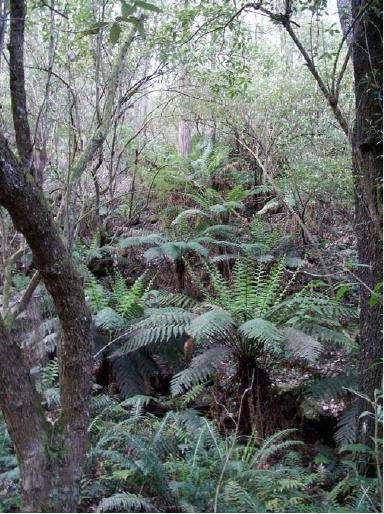Damp Forest (EVC 29)
By Murray Ralph

An example of remaining Damp Forest EVC in a sheltered gully near Nolans Creek Track (photo by Tibor Hegedis)
In the Wombat State Forest, damp forest occurs in the higher rainfall areas where annual rainfall is between 950-1200mm per annum. It is usually restricted to sheltered gullies on alluvial soils, often in association with Shrubby Foothill Forest.
The tall overstorey (to 35m) is dominated by Messmate (Eucalyptus obliqua) with a lower tree layer of Blackwood (Acacia melanoxylon) to 20m. The understorey is characterised by a dense small tree layer dominated by Musk Daisy-bush (Olearia argophylla), Shrub species that may be present include Prickly Moses (Acacia verticillata), Prickly Currant-bush (Coprosma quadrifida), Hop Goodenia (Goodenia ovata) and Hazel Pomaderris (Pomaderris aspera).
The ground flora consists of a variety of ferns, native herbs and grasses. The most common fern is usually Fishbone Water-fern (Blechnum nudum), but other species such as Mother Shield-fern (Polystichum proliferum) and Hard Water Fern (Blechnum wattsii) are also present. Rough Tree Fern (Cyathea australis) would have once been very common in this EVC, but now tends to be less commonly found.
Native herbs include Tasman Flax-lily (Dianella tasmanica), Bidgee Widgee (Aceana novae-zealandiae) and Turquoise Berry (Drymophila cyanocarpa). Grasses include Forest Wire Grass (Tetratheca juncea). Red-fruited Saw-sedge (Gahnia sieberiana) can also be present.
All EVC are assigned a conservation significance based on the extent to which they have been cleared from their former range. Damp forest is classified as being vulnerable. The main current threats to this EVC in the Wombat State Forest include climate change, altered fire regimes, loss of hollow bearing trees, weed invasion and altered hydrology.
